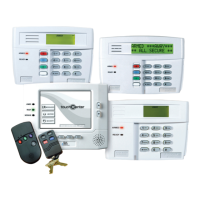
Do you have a question about the First Alert FA162C and is the answer not in the manual?
| Battery Backup | Yes |
|---|---|
| Alarm Decibel Rating | 85 dB |
| Color | White |
| Warranty | 10-year limited warranty |
| Interconnectability | Yes, up to 18 devices |
| Features | End-of-Life Timer |
| Battery Type | 9V |
Introduction to the First Alert Professional Partitioned Security System and its features.
Explains a single alarm system providing two independent protection areas for separate users.
Details how sensing devices are assigned to various 'zones' for system monitoring.
Covers STAY, AWAY, INSTANT, MAXIMUM modes and zone bypassing for burglary protection.
Explains the assignment and use of personal security codes for system functions.
Information on the system's fire protection capabilities and smoke detectors.
How alarms are indicated, displayed, and how the system retains alarm information.
Features for accessing the system remotely via phone and pager notifications.
Explanation of preset time delays for exiting and entering the premises.
How to restart the exit delay after the system has been armed in STAY mode.
Details what occurs if an entry/exit door is faulted at the end of the exit delay.
How a common zone, shared by partitions, operates and its specific rules.
General description of keypads, displays, and sounders for system control.
Details on keypads with a 2-line, 32-character alphanumeric LCD.
Details on keypads with a 1-line, 16-character alphanumeric LCD.
Explanation of status indicators and meanings on fixed-word keypads.
Describes the LCD display and indicator lights (READY, ARMED).
Explains the functions of OFF, AWAY, STAY, MAXIMUM, TEST, BYPASS, INSTANT keys.
Details functions of CODE, CHIME, READY, and numeric keys (0-9).
Information regarding the use of emergency panic keys.
Procedure to check for open zones before arming the system.
Steps to view faulted zones and secure them before arming.
Instructions for arming perimeter protection with entry delay.
What to listen for and expect after arming in STAY mode.
Instructions for arming perimeter protection without entry delay.
What to listen for and expect after arming in INSTANT mode.
Instructions for arming the entire system with entry delay.
What to listen for and expect after arming in AWAY mode.
Procedure for arming both partitions simultaneously in AWAY mode.
Instructions for arming the system without entry delay for maximum protection.
What to listen for and expect after arming in MAXIMUM mode.
How to use the OFF key to disarm the system and silence alarms.
Steps to disarm the system and silence burglary alarms.
How alarm messages are displayed and cleared after disarming.
How to use the BYPASS key to leave specific zones unprotected.
Steps to enter security code and zone numbers to bypass.
How to bypass all open zones automatically if programmed.
Procedure to view previously bypassed zones.
How to use the 9 key to activate or deactivate the chime feature.
Steps to turn the chime mode on and confirm activation.
Steps to turn the chime mode off and confirm deactivation.
How to use panic keys to manually activate silent or audible alarms.
Explanation of silent, audible, personal, and fire emergency alarms.
How keypad commands can control lights or other devices.
Command sequence for activating specific devices.
Command sequence for de-activating specific devices.
Assigning different security codes to users and their numbers.
Specific code for arming/disarming under certain conditions.
Code used under threat to notify a monitoring company.
Using the # key instead of a security code for arming.
Procedure to add or change user codes and assign user numbers.
Procedure to remove a user's code from the system.
Procedure to change the primary master security code.
How to put the system into Test mode for checking protection points.
Steps to disarm the system and prepare for testing.
Procedure to enter the security code and press the TEST key.
Instructions for listening to sounders and testing zones.
Procedure to exit the system test mode.
Explanation of the 'CHECK' indication and associated beeping sound.
Indicates problems with specific zones or system wiring.
Indicates issues with the telephone line monitor feature.
Indicates a failure in the telephone communication system.
Signals for low system battery or low wireless sensor battery.
Indicates loss of AC power, system disabled, or communication issues.
Overview of the 24-hour fire alarm system and its activation.
Actions to take in the event of a fire emergency.
Steps to silence and clear a fire alarm display.
Recommended steps for planning and practicing fire escape routes.
General advice on system maintenance, including weekly testing.
Information on detecting and replacing low batteries in wireless sensors.
How to silence low battery warning tones at the keypad.
Advice on cleaning system components like keypads and sensors.
Overview of common system functions and their procedures.
Quick steps for arming, disarming, and checking system status.
Procedures for bypassing zones and managing chime mode.
Quick steps for system testing, user management, and code changes.
Definitions for ARM/DISARM, KEYPAD, ZONE, PARTITION, BYPASS.
Definitions for DELAY ZONE and DAY/NIGHT ZONE.
Details for insured's name, address, insurance company, and policy number.
Information on who is notified and the system's power source.
Specifies locations of smoke detectors and burglary devices.
Discusses general system limitations and potential failure reasons.
Details limitations of motion detectors and alarm warning devices.











